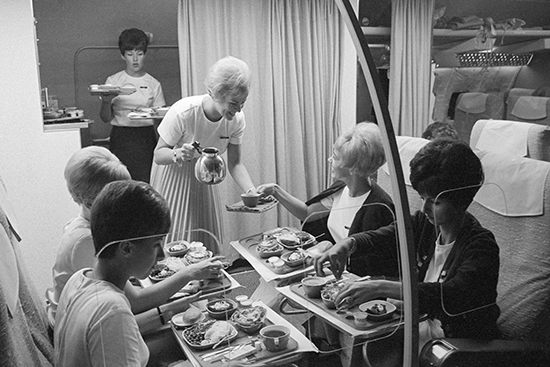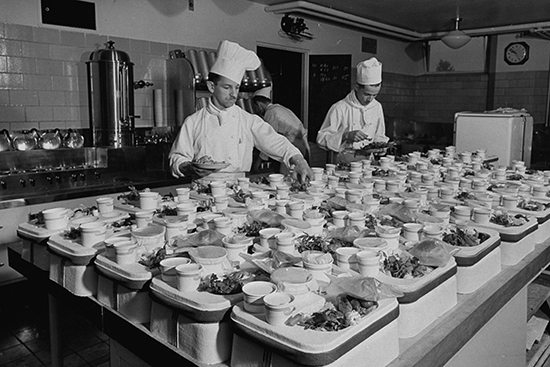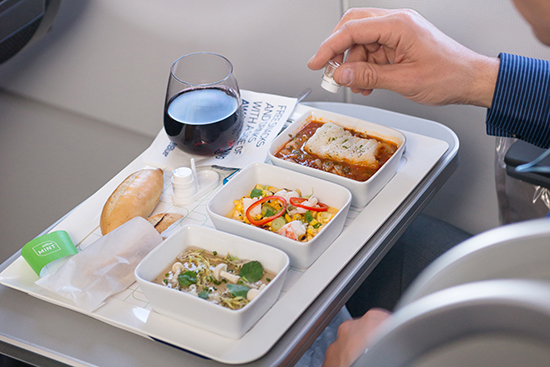航空餐饮简史

|
尽管航空餐食在美食界没有什么名气,但它属于相对近现代的一个特权,而且并非所有的飞机乘客一直都能吃到。航空餐食首次出现于1919年,由执行伦敦到巴黎航线任务的Handley-Page航班提供。2017年的《旅游+休闲》杂志称,当时的可选菜品“通常包括冷炸鸡,水果沙拉和制作精美的三明治,盛放在柳条篮中,柳条篮下方则是当时最轻的陶瓷器皿。” 在科技的进一步推动下,飞机功能不断发展,乘客在上个世纪30年代见证了机上厨房的诞生,它将以果腹目的的食品变为了更加贴心的体验。烹饪历史学家、《空中的食品:令人吃惊的航空餐饮历史》一书的作者理查德·福斯向《旅游+ 休闲》杂志透露,“有时候,飞机甚至会为了使用午餐而降落,在航班挂架或在餐桌上为客户提供餐食,而飞机则在加油后继续完成剩余的行程。” 在上个世纪40年代,几何形状的托盘(我们如今所熟悉的托盘的雏形)中出现了冷冻食品的身影。当机上餐饮成为一项固定服务时,航空公司采用了各种办法来节省时间,包括将玻璃器皿改为塑料器皿,减少了机上乘务员洗碗的时间。由于被冷冻的食品会可在放置数小时后向乘客提供,乘客因此而获得了更加丰富的菜单选项。这一事实伴随着航班成本的下降,而航空公司甚至将重点也转移至如何准备食物以及如何在飞机上提供餐饮服务。 |
Although not renowned for their excellence in culinary circles, in-flight meals are a relatively recent privilege to which fliers haven’t always been treated. The first ever airline meal was served in 1919 on a Handley-Page flight from London to Paris. According to Travel + Leisure in 2017, selections at the time “typically included cold fried chicken, fruit salads and elegantly composed sandwiches, served in wicker baskets on the lightest chinaware servers could find.” As technology propelled planes’ capabilities further, fliers witnessed the arrival of on-board kitchens in the 1930s, which turned the food offerings from mere sustenance to more thought-through experiences. According to Richard Foss, a culinary historian and author of Food in the Air and Space: The Surprising History of Food and Drink in the Skies, told Travel + Leisure that “sometimes planes would even stop off for lunch, serving customers in the airline hanger or at picnic tables while the plane refueled before continuing with the remainder of the trip.” It was in the 1940s when frozen meals began making their way into the geometric trays we consider familiar today began to take shape. A variety of methods to save time when serving began to take hold, including the discarding of glassware for plastic, cutting off the need for the crew to wash dishes. The ability to freeze food and serve it hours later eventually led to more menu choices—a fact that, paired with lower flight costs, shifted even more focus on the ways the food was being prepared and served on board. |

|
它又将我们带回到今天:明星大厨与航空公司联袂推出更加新颖、豪华的餐食,全世界对健康关注的提升,旅行频率的增加,以及互联网的到来,能够让乘客们对其乘机体验进行公开评价(这个趋势最终影响了机票销售)。有鉴于上述所有因素,人们对机上餐饮的预期比以往任何时候都要高。 菜单策划 产品开发总监玛利亚·斯特亚诺娃估计,全球大概有12家知名的公司能够提供专业的航空餐饮服务。她说:“虽然他们工作的设施跟仓库一样,但在制作航空公司专用食品方面却是异常的井井有条。”餐饮服务会聘请专家级的航空大厨来设计菜单,并在公司内部制作餐饮,然后按照约束航空业的众多法律法规,在其所在的地区销售其食品。 作为全球最大的机上餐饮服务提供商之一,LSG Sky Chefs的合作方包括捷蓝航空、美国航空和达美航空等。公司网站称,“其主要业务功能是为国内、国际航班准备、提供餐饮和零食” 。 在设计菜单时,大厨非常在意海拔和气压对乘客味蕾的影响。机舱内气压会达到海平面6,000-8,000英尺海拔高度的水平,因此,在机舱内烹饪新鲜餐食几乎是不可能的,而且也会改变即将提供的预先封装食品的味道。受高度影响,部分味蕾和嗅觉也会变得麻木,而这也间接要求食品制作商增加一些旅客们在地面上并不需要的味道。 |
Which brings us back to today: Newer, lavish meals thought up by celebrity chefs in partnership with airlines, a greater focus on health globally, a higher frequency of travel, and the advent of the Internet, enabling passengers to to publicly review their on-board experiences (a trend that ends up affecting ticket sales). Take all that together and expectations placed upon airline meals are higher than ever before. Menu Planning There are probably a dozen well-known companies with dedicated catering services for airlines, estimates Mariya Stoyanova, director of product development at JetBlue Airways. “They work out of warehouse-like facilities, but are very well organized to produce food specifically for airlines,” she says. The catering services hire expert airline chefs to work out menus, produce the meals in-house, and deliver them across their region obeying the many laws and guidelines that dominate the flying industry. One of the world’s largest providers of in-flight catering and services is LSG Sky Chefs. Working with JetBlue, American Airlines, and Delta, among others, LSG Sky Chefs’ “primary business function is to prepare and deliver meals, beverages and snacks to aircraft for domestic and international flights,” according to the company’s website. In drafting a menu, chefs are hyper aware of the effect that altitude and air pressure have on fliers’ taste buds. The air pressure in cabins climbs to 6,000 to 8,000 feet above sea level, which makes the preparation of fresh meals on-board nearly impossible and also mutates the flavor of the pre-packaged food that is being served. Taste buds and the sense of smell go partially “numb” given the altitude, indirectly requiring food purveyors to add kicks of flavor that fare consumed on the ground doesn’t call for. |

|
在餐饮中添加额外的盐和调味酱似乎是一种常见的做法。斯特亚诺娃对此表示认同:“你的味蕾在空中会发生变化”。随后她又评价了捷蓝航空的首选应对方法:“我们试图利用新鲜的植物、辛香料、热度和鲜味来提味,只是为了确保餐饮的本应具有的口感和嗅觉。” 1994-2001年期间LSG Sky Chefs伦敦希斯罗机场IT与规划经理奥尔夫·帕梅尔斯对斯特亚诺娃有关周边环境的观点表示认同,他解释说:“未来会受到海拔的影响。因此设计菜单的各位行政主厨一直尝试在不超过餐饮预算成本的情况下改善口感。” 在精简餐饮成本方面,帕梅尔斯解释说,航空公司通常会设定每份餐饮的成本,而餐饮公司则会按照这个成本来制作餐饮。他还表示:“食物放的太多,公司就会亏本,食物不够,又会被罚,因此这些公司通常是食品制作工厂、快餐提供商和食品经销商的结合体。” 一流的大厨 与大厨合作已经成为了这些飞行行家经常采用的一种方式,因为此举可以在不超过预算和法律界限的情况下提升其服务质量。捷蓝航空围绕自行推出的“全新的高端旅行体验”Mint,与纽约市Saxon + Parole团队开展合作,主打“艺术餐饮”服务。法航曾与大厨乔尔·罗布康合作。新加坡航空在数年前启用了戈登·拉姆西,聘请其担任顾问。2011年,英航邀请希斯顿·布鲁门彻来提供其专长。 虽然乘客记住的是实际提供的食物,但这类食物的准备过程(受到行业标准严格约束的一种操作)才是决定食物“健康与否”的关键要素。 帕梅尔斯解释说:“餐饮组件可在航班起飞前24小时通过冷冻方式运输并进行密封。因此,如果计算供应商最初的制作和储存时间,有些食品在摆上桌板之前可能已经放置了2-3天之久。为了让餐车能够符合食品安全标准,它们必须在冷藏区域先放置2-3个小时,以达到所需的温度。” |
Peppering each meal with extra salt and sauces seems to be common practice. “Your taste buds are not the same in the air,” confirms Stoyanova, before addressing JetBlue’s preferred practices: “We try to bring the flavor forward with fresh herbs, spices, heat, umami—just to make sure it tastes and smells the way it’s supposed to be.” Alf Pomells, the IT and planning manager for LSG Sky Chefs at London Heathrow between 1994 and 2001, echoes Stoyanova’s point about the surrounding environment: “Taste buds are affected by altitude,” he explains. “So the executive chefs who design the menus are constantly trying to balance improved taste versus the budgeted cost of the meal.” In budgeting meal costs, Pomells explains, airlines usually set a cost per meal, and the caterer tries to manufacture a meal in line with that cost. “Put too much food,” he continues, “and they lose money, don’t put enough and there will be penalties to be paid—so they are a combination of factory, fast food provider, and food distributor. First Class Chefs Partnering with chefs has become a popular way across these flying couriers to step up the quality of their offerings while remaining within budget and lawful parameters. JetBlue works with the team at New York City’s Saxon + Parole on the airline’s Mint experience, a self-defined “refreshing take on a premium travel experience” featuring “artisanal dining” offerings. Air France once partnered with Joel Robuchon. Singapore Airlines enlisted the help of Gordon Ramsay as a consultant years ago, and Heston Blumenthal was tapped by British Airways back in 2011 for his expertise. Although the actual food being served is what passengers remember, it is the preparation of said food—a practice highly guarded by industry standards—that determines the “healthiness” of it all. “Meal components can be brought in frozen and assembled up to 24 hours before a flight,” explains Pomells. “So, once you add the original pre- and storage time for the vendors, some of the food could be 2-3 days [old] before consumption. In order for the carts to comply with food safety standards, they have to sit in a refrigerated area for two to three hours to get down to the required temperature.” |

|
当然,各家航空公司的流程略有不同。斯特亚诺娃敦促捷蓝航空不要使用任何冷冻食品。她说:“我们的理念是,所有的食物都应该用新鲜材料制作。” 帕梅尔斯则进一步指出,他所见到的“最新鲜的”食物仅面向商务和头等舱乘客提供,“仅仅是因为用餐的人要少得多。”他说,航空公司配有专业的团队为这些乘客手工制作所有餐饮,因此这就是“坐在餐馆里点菜与开车在道边快餐店取餐的区别”。 冷冻食品的是与非 总的来说,冷冻食品在航空界的经历比较坎坷。美联航前空乘(1968-2009年)戴安娜·戈沃说:“1968年,飞机上的食物非常好,主要原因在于航空公司有自己的厨房。如今,它们使用的是外部提供商,因此并不受航空公司的控制。在过去,纽约航班会从当地熟食店采购熏鲑鱼,这些鲑鱼是如此之美味,以至于一些女士会将其放在自己的手提包中!” 虽然帕梅尔斯和戈沃曾对当前航空公司在提供餐食时的一些做法表示了明确的谴责,但他们也认为,从整体来讲,机上餐饮应遵从某些可靠的卫生标准。帕梅尔斯说:“我每一年都会飞十几次,尽管大多数食物也就勉强达到了平均水平,但总比饿肚子强。因此,即便是为了摄取食物中的能量,这些餐食也是必要的,而且其品质也在改善。”当被问及自己在飞机上所提供的食物是否健康时,戈沃回答道:“是的。我也会吃机上餐食,都是那些头等舱和经济舱剩下的食物。” 那么餐厅是如何在遵守各市卫生检查员要求的同时,还能利用独到的菜单来满足乘客的各类需求?那是因为全球航空公司餐饮服务会制作不同品质的食物。帕梅尔斯称,就空中旅行而言,乘客通常会发现,各家航空公司的餐饮存在参差不齐的现象。 帕梅尔斯说:“当你坐飞机时,你享用的餐食可能来自于两到三家不同的公司,并非所有的航空公司在各个国家都有厨房,每个机场就更少了。你从希斯罗到迪拜航段的餐食可能十分可口,但从迪拜到吉隆坡的下一餐则是由不同厨房准备的,而且[来自于]不同厨师提供的不同菜单。” 帕梅尔斯认为,最好总是根据饮食限制来索要特别的餐食。为什么?特别餐食是在起飞前预订的,因此也就更新鲜,而且更接近航空公司大厨的原创菜单。(财富中文网) 译者:冯丰 审校:夏林 |
Of course, processes slightly differ across the aisles. Stoyanova urges that JetBlue doesn’t use anything frozen. “Our philosophy is everything needs to be made with fresh ingredients,” she says.” Pomells advances that the “freshest” meals he’s seen are catered to first and business class passengers, “simply because the numbers are a lot lower.” Those fliers, he says, are entrusted to dedicated teams that hand-prepare all the meals, so it’s the difference between getting “an à la carte meal from a restaurant and getting a meal from a drive-through takeaway.” Futzing With Frozen Food Frozen meals, in general, have an uneasy history in the airline industry. “In 1968, the food was very good, mainly due to the fact that the airlines had their own kitchens” says Diana Goo, a former flight attendant at United Airlines from 1968 to 2009. “Now, they are using outside vendors, which takes the control out of the airlines’ hands. In the past, the New York flights had lox from the local delis—it was so good that some of the women stashed it in their handbags!” Although clearly denouncing some of the practices currently used to provide fliers with foods, Pomells and Goo agree that, overall, in-flight meals abide by some sort of trustworthy health standard. “I fly up to a dozen times a year and, while most food is barely average, it’s better than going hungry,” says Pomells. “So even if it’s just for the energy it provides, the meals are necessary and the quality is improving.” When asked whether she considered the food she served on planes healthy, Goo responds “Yes. I ate the in-flight meals [also], whatever was left over from first class and coach.” And just how restaurants follow municipal health inspector guidelines but answer those requirements in all different ways with unique menus, airline catering services across the globe produce foods of differing qualities. In the case of air travel, the variation between carriers is usually what people are observing, according to Pomells. “When you take a flight, you can be catered by two or three different companies, as not all have kitchens in every country, much less every airport,” Pomells says. “The meal you get from Heathrow to Dubai might be great, but your next meal from Dubai to Kuala Lumpur is prepared by a different kitchen, [following] a different menu with different chefs.” Pomells suggests the best thing to do is always request a special meal based on dietary restrictions. Why? Special meals are ordered closer to take off, making them fresher and closer to the airline chef’s original vision for the menu. |













